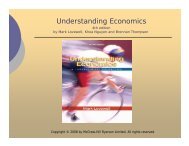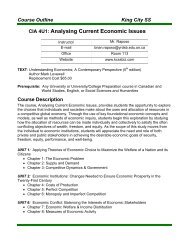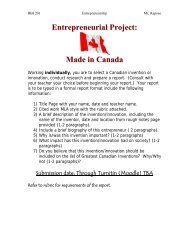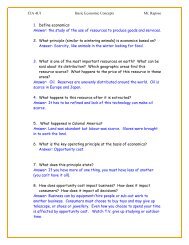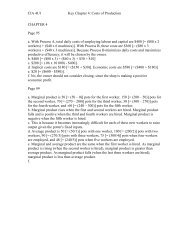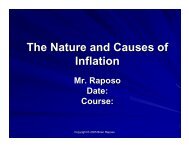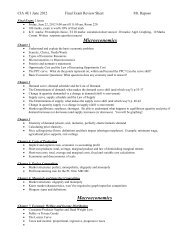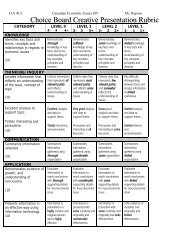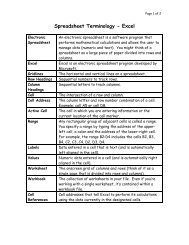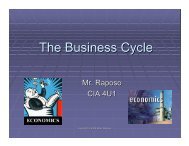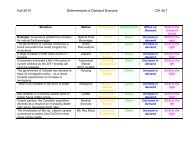Intro to Economics Smartboard Lesson
Intro to Economics Smartboard Lesson
Intro to Economics Smartboard Lesson
You also want an ePaper? Increase the reach of your titles
YUMPU automatically turns print PDFs into web optimized ePapers that Google loves.
<strong>Intro</strong>duction <strong>to</strong> <strong>Economics</strong><br />
BR1<br />
Mr. Raposo<br />
KCSS<br />
Course: CIA 4U1
Slide 1<br />
BR1<br />
This is an excellent lesson <strong>to</strong> construct a mind map on the white board with.<br />
Brian Raposo, 07/03/2007
Agenda<br />
•Textbook distribution<br />
•Student Agenda<br />
•Course Syllabus<br />
•If you had a million dollars? Activity<br />
•What is <strong>Economics</strong>?<br />
•Class Activity: Scarcity, choice and<br />
opportunity cost
If I had a million dollars!<br />
•Rapid writing<br />
•1 minute<br />
•What would you buy?
Question:<br />
•Same list: how much of that could you buy<br />
right now??
Basic Economic Problem<br />
•Humans have unlimited needs/wants!
Consumers obtain/use various<br />
goods and services ………..
….and these goods and services<br />
give them satisfaction (utility)
Satisfaction-Rolling S<strong>to</strong>nes
Utility: (economists term for pleasure or<br />
satisfaction)
Here’s the Problem!<br />
•Society has limited resources <strong>to</strong> satisfy our<br />
unlimited human wants<br />
•These resources are natural, capital,<br />
human and entrepreneurial (fac<strong>to</strong>rs of<br />
production)
The Pie is not large enough for all of us <strong>to</strong><br />
get our fill.
..this results in Scarcity!!!!!
Humans must make choices!
…making choices have costs!
Game Plan<br />
•<strong>Intro</strong>duce www.kcssbiz.com<br />
•Re-cap “The Economic Problem”<br />
•Opportunity Cost-Small Group Activity<br />
•Buying on Credit-Activity<br />
•Exit Card<br />
•HW Begin Chapter 1 from course outline
Opportunity Cost (what is given up, or the<br />
next best choice)
Question:<br />
•What is the cost (opportunity cost) of<br />
attending this class??????
Economic Choice<br />
• Economists assume that economic<br />
decision-makers maximize their own utility.<br />
◦Decision-makers must keep in mind the<br />
opportunity cost of each alternative.<br />
◦Opportunity cost is defined as the utility of the<br />
best forgone alternative.
Choice and Scarcity<br />
•Choices must be made given our limited<br />
resources among alternatives.<br />
•Since resources are limited in supply and<br />
fully employed, any increase in the<br />
production of one product will require<br />
resources <strong>to</strong> be shifted away from the<br />
production of another product.
<strong>Economics</strong> Defined:<br />
• <strong>Economics</strong> is the study of how society<br />
distributes its limited resources given<br />
its unlimited needs and wants.
Class Activity<br />
• Scarcity and Choice<br />
Example situation: Suppose someone you know has $80 in her<br />
bank account until her next pay cheque in two weeks’ time. She<br />
finds herself facing the following scenarios:<br />
• her supervisor at work has informed her that she is<br />
responsible for purchasing a new uniform immediately and it<br />
cannot be bought on credit ($30.00)<br />
• a class trip has been planned at school and the money is due<br />
<strong>to</strong>morrow ($50.00)<br />
• her friends want her <strong>to</strong> join them for a concert of her<br />
favourite band this coming weekend ($120.00)<br />
• she really needs some new jeans <strong>to</strong> wear <strong>to</strong> the concert<br />
($60.00)<br />
• her cell phone bill is past due ($80.00)
Exit Card<br />
• This is an example of someone with unlimited<br />
wants, but limited resources.<br />
1. Describe an example of an economic problem<br />
in your life, whereby you were faced with<br />
unlimited wants, but limited resources.<br />
2. How did you go about maximizing utility based<br />
on your choice of actions?<br />
3. Describe the opportunity costs you experienced<br />
as a result of your choices.
Micro vs Macro: We will look at both!<br />
◦Microeconomics focuses on individual<br />
consumers and businesses.<br />
◦Macroeconomics is a broader or<br />
national view of an economy.
Positive vs. Normative Statements<br />
Positive Statements<br />
•scientific (or factual) statements about<br />
economic behavior<br />
•concerned with “what is”<br />
Normative Statements<br />
•value based statements<br />
•concerned with “what should be”
Examples:<br />
•Positive Statement: The unemployment rate<br />
in eastern Canada is 18% (hypothetical)<br />
•Normative Statement: The unemployment<br />
rate in Canada should be reduced from<br />
18%<br />
•Economists are concerned with positive<br />
statements: “what is”.<br />
•Policy makers (government) decide “what<br />
should be”
Fac<strong>to</strong>rs of Production: Societies Limited<br />
Resources<br />
• Natural Resources<br />
• Capital Resources<br />
• Human Resources
Economic Models<br />
• Economic models:<br />
◦simplify economic reality<br />
◦show how dependent variables are affected by<br />
independent variables<br />
◦include inverse and/or direct relationships<br />
◦incorporate a variety of assumptions such as<br />
ceteris paribus<br />
◦are classified as part of either positive<br />
economics or normative economics
Glossary: Let’s Begin!<br />
Title a new page-glossary, Unit 1, <strong>to</strong>day’s<br />
date and define the following terms (Ch.1)
The Basic Economic Questions<br />
• There are three basic questions any<br />
society must answer:<br />
◦what <strong>to</strong> produce ?<br />
◦how <strong>to</strong> produce ?<br />
◦for whom <strong>to</strong> produce ?
Economic Systems<br />
• The three economic systems<br />
◦Traditional economy<br />
◦Market economy<br />
◦Command economy
Types of Market Systems
Economic Systems<br />
• Most countries have mixed economies.<br />
◦Modern mixed economies include both private<br />
and public sec<strong>to</strong>rs.<br />
◦Traditional mixed economies combine<br />
traditional sec<strong>to</strong>rs with private and/or public<br />
sec<strong>to</strong>rs.
Economic Systems
Gallery Walk<br />
•Instructions:<br />
•You will be given one sticker for each<br />
piece of flip chart paper around the room.<br />
•Place one (only one) sticker on each chart<br />
paper on the paper area that represents<br />
your answer<br />
•Example:
Economic Goals<br />
• There are seven major economic goals:<br />
◦economic efficiency<br />
◦income equity<br />
◦price stability<br />
◦full employment<br />
◦viable balance of payments<br />
◦economic growth<br />
◦environmental sustainability
Complementary and Conflicting<br />
Economic Goals<br />
• Economic goals may be complementary.<br />
◦An example is the relationship between full<br />
employment and economic growth.<br />
• Economic goals may be conflicting.<br />
◦An example is the relationship between price<br />
stability and full employment.
The Production Possibilities Model<br />
• The production possibilities model is<br />
based on three assumptions:<br />
◦an economy makes only two products<br />
◦resources and technology are fixed<br />
◦all resources are employed <strong>to</strong> their fullest<br />
capacity
The Production Possibilities Curve<br />
• The production possibilities curve shows a<br />
range of possible output combinations for<br />
an economy.<br />
◦It highlights the scarcity of resources.<br />
◦It has a concave shape, which reflects the law of<br />
increasing opportunity costs.
The Production Possibilities Curve<br />
Production Possibilities<br />
Schedule<br />
Banana’s Au<strong>to</strong>mobiles point<br />
on graph<br />
2000 0 a<br />
1600 1 b<br />
900 2 c<br />
0 3 d<br />
Production Possibilities Curve<br />
a<br />
2000<br />
b f unattainable<br />
1600<br />
Banana’s<br />
c<br />
900<br />
e<br />
inefficient<br />
d<br />
0 1 2 3<br />
Au<strong>to</strong>mobiles
The Law of Increasing Costs<br />
Production Possibilities Schedule<br />
Bananas Opportunity Au<strong>to</strong>mobiles point<br />
Cost of on graph<br />
Au<strong>to</strong>mobiles<br />
2000 0 a<br />
100<br />
1600 1 b<br />
400<br />
900 2 c<br />
900<br />
0 3 d<br />
Production Possibilities Curve<br />
a<br />
Bananas<br />
2000<br />
b<br />
1600<br />
900<br />
c<br />
d<br />
0 1 2 3<br />
Au<strong>to</strong>mobiles<br />
As the quantity<br />
of au<strong>to</strong>mobiles<br />
rises, so does their<br />
opportunity cost.
Shifts in Production Possibilities<br />
How can this economy gain more au<strong>to</strong>mobiles and banana’s?<br />
Production Possibilities Curve<br />
Bananas<br />
2000<br />
Through improved<br />
technology or<br />
better education<br />
this economy<br />
can gain more of<br />
both goods<br />
(represented by<br />
a shift of the<br />
PPC outward<br />
and <strong>to</strong> the right).<br />
0 3<br />
Au<strong>to</strong>mobiles
The Founder of Modern <strong>Economics</strong><br />
• Adam Smith:<br />
◦Explained how<br />
specialization of labour<br />
increases production<br />
◦laissez faire (leave it<br />
alone), argued that<br />
government should not<br />
intervene in economic<br />
activity<br />
◦The “invisible” hand<br />
lead by self interest will<br />
result in economic gain<br />
and efficiency in<br />
markets



